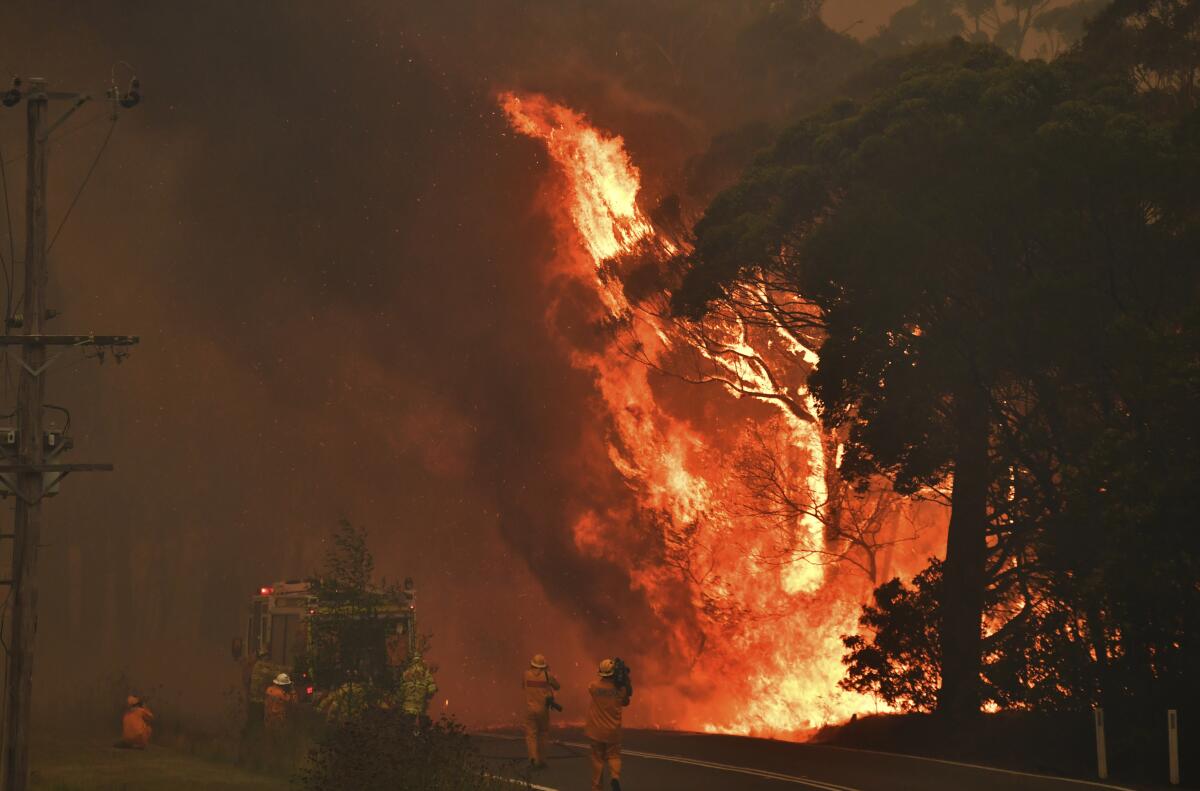Australia battles ‘catastrophic’ wildfires

- Share via
PERTH, Australia — Australia’s most populous state was paralyzed by “catastrophic” fire conditions Saturday amid soaring temperatures, while one person died as wildfires ravaged the country’s southeast, officials said.
“Catastrophic fire conditions are as bad as it gets,” New South Wales Rural Fire Services Commissioner Shane Fitzsimmons told reporters. “Given we have a landscape with so much active fire burning, you have a recipe for very serious concern and a very dangerous day.”
Areas in western Sydney were forecast to hit 115 degrees. Cooler air was expected to move through New South Wales late Saturday, although authorities warned that strong winds could push fires in dangerous new directions.
New South Wales is in a seven-day state of emergency, with about 2,000 firefighters battling 100 wildfires.
Two firefighters died Thursday battling blazes southwest of Sydney. Geoffrey Keaton, 32, and Andrew O’Dwyer, 36, were in a truck convoy southwest of Sydney when a tree fell and caused their vehicle to roll off the road.
Authorities confirmed Saturday that one person died and 15 homes were destroyed in South Australia as a wildfire ravaged the Adelaide Hills on Friday, just 25 miles from the state capital, Adelaide. Another person was critically injured after fighting to save his home from the fires.
That follows the death of a 24-year-old man in a road crash in South Australia on Friday, which sparked a fire in the area of the Murraylands.
Authorities said 23 firefighters and several police have also suffered injuries, as more than 98,842 acres burned across South Australia.
“It is going to be a real scene of devastation, especially for those people in the Adelaide Hills who have been most affected,” South Australia Premier Steven Marshall said. “We know that in addition to the buildings and vehicles lost, there are very significant losses in terms of livestock, animals, crops, vineyards.”
The annual Australian fire season, which peaks during the Southern Hemisphere summer, started early after an unusually warm and dry winter. About 7.4 million acres of land have burned nationwide in the last few months, with nine people killed and more than 800 homes destroyed.
The devastation has put pressure on Prime Minister Scott Morrison, who has received criticism for going on a family vacation in Hawaii during the wildfire crisis. He apologized on Friday for any offense “caused to any of the many Australians affected by the terrible bushfires by my taking leave with family at this time.”
Morrison cut short his vacation and returned home Saturday night. He was due to visit the New South Wales Rural Fire Service headquarters on Sunday.
Debate has reignited on whether Morrison’s conservative government has taken enough action on climate change. Australia is the world’s largest exporter of coal and liquefied natural gas.
Fatih Birol, International Energy Agency executive director, believes Australia has missed opportunities to mitigate the impact of coal.
“I find the Australian energy debate far too emotional, far too nervous and far too hot. It is hotter than the climate change itself,” he told the Sydney Morning Herald and the Age.
Protesters on Thursday camped outside Morrison’s Sydney residence demanding urgent action on climate change.
Morrison, who critics have deemed a climate change skeptic, conceded this month that “climate change along with many other factors” has contributed to the wildfires.
More to Read
Sign up for Essential California
The most important California stories and recommendations in your inbox every morning.
You may occasionally receive promotional content from the Los Angeles Times.












